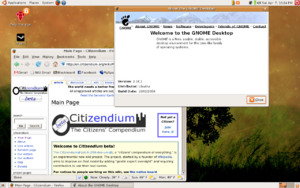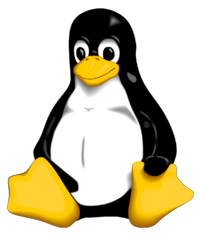Linux (operating system)
| Linux |

|
| The GNOME desktop on Ubuntu Linux 6.10 |
| Website: http://www.linux.org |
| Developer: The Open Source community |
| OS family: Unix-like |
| Source model: Open source |
| Latest stable release:[1] |
| Supported platforms: x86, x86-64, ia64, DEC Alpha, Motorola 68k, SUN Sparc, ARM, PowerPC |
| Kernel type: Monolithic kernel |
| Default user interface (most distros): GUI |
| License: GNU General Public License |
| Working state: Current |

Linux is an operating system remarkable for the community-driven effort which led to its completion. It can run on the same IBM compatible PC hardware as the Windows and Mac operating system families, can be a very low-cost alternative to Windows, and provides a user experience that is nearly identical to the much older Unix operating system. Its feature set is comparable to the operating systems sold by Microsoft and Apple.
Linux is open source software, which means it is written, and improved upon, through a community effort, and it can be obtained and used for free by anyone. Furthermore, numerous companies are able to earn money by offering "supported distributions" of Linux which have certain guarantees in terms of reliability; customers who pay for one of the "supported" versions of Linux (such as Red Hat, or others) can rest assured that someone will help them if a serious problem arises. These specially packaged versions of Linux are called Linux distributions.
Linux has experienced marketplace success both as a server (accessed remotely over a network by multiple users simultaneously) and as a single-user desktop. Furthermore, it can run on a variety of hardware platforms, including, including Intel i686, AMD64, SPARC, and Xbox systems.
Origins
The origins of Linux are remarkable. The first Linux kernel was written by an upstart college student from Finland in 1991 in defiance of a competing operating system, Minix, creation of a renowned professor of computer architecture. The ensuing debate between Linux creator Linus Torvalds and Dr. Andrew S. Tanenbaum[2], has been retold repeatedly with amusement and amazement (please see the Monolithic versus Microkernel article for more information). Initially, Torvalds came down on the side of what is practical and can be implemented easily, and Tanenbaum came down on the side of academic theory. But Linux soon won Professor Tanenbaum over.
Linux is pronounced like Minix. The name Linux was created by combining Linus with the "x" in Unix. Torvalds originally intended to call the project Freax, for Free and Freak, with the "x" denoting that it is Unix-like, but after one of his colleagues named the system's FTP directory after him, the name stuck.[3]
Before Linux was written, only the non-free Minix kernel was available for use on the same low-cost hardware used by IBM compatible PC's. In 1984, Dr. Richard Stallman founded the landmark Free Software Foundation, a non-profit organization, in which work was done throughout the late 1980's towards creating a free Unix-like operating system. The new software was to be called the GNU[4] system (GNU stood for GNU's Not Unix). The GNU project produced highly successful tools, including the GNU C compiler, GNU debugger, and the Emacs text editor. However, the project still lacked a kernel for its new operating system. When Linux came along, the GNU developers adopted it and combined their tools with it, creating a full-fledged operating system with good tools. Stallman's Free Software Foundation was the first open source software project, and Linux had became its poster child.
At this point, there was widespread talk about changing the name Linux to GNU/Linux to credit those who worked on the tools which fleshed out the Linux kernel into a full-fledge operating system. But Linux creator Linus Torvalds said that "calling Linux in general just 'GNU/Linux' I think is ridiculous."[5]. The name remained simply Linux.
Applications running on Linux
Aside from the GNU project's applications, Linux is capable of running many applications of all natures, from games and graphic editors to Integrated Development Environments and web servers. Among the most commonly used applications are The GIMP photo editing tool, which is commonly referred to as a free alternative to Photoshop, Firefox, a feature-complete, tabbed web browser, and OpenOffice, which is a free, full-featured alternative to the Microsoft Office suite. The GIMP, Firefox and OpenOffice are all cross-platform as well, meaning they run on Microsoft Windows and Mac OS X.
Unlike Microsoft Windows NT, Linux itself is not a graphical system. Instead, Linux relies on a graphical layer to output bitmap images. The most common application for this is called X.org, commonly referred to as just X. X.org is a very minimal program that purposely does as little as possible. Users do not normally see it, but the results of its work. X.org serves as a layer between the kernel and the desktop environment or window manager. Window managers, like Openbox or wmii, are only able to manage windows and desktops, while desktop environments, such as GNOME, KDE and Xfce, provide advanced graphical functionality, such as the ability to process text, organize photos or chat online.
References
- ↑ "Top 10 Distributions". Retrieved on 2007-04-09.
- ↑ Andrew S. Tanenbaum, Professor of Computer Science. Vrije Universiteit, Amsterdam, The Netherlands. Retrieved on 2007-04-06.
- ↑ USENET post on Linux naming (Retreived 06 April 2007).
- ↑ About the GNU Project (Retreived 06 April 2007).
- ↑ The "GNU/Linux" and "Linux" Controversy (Retreived 06 April 2007).
